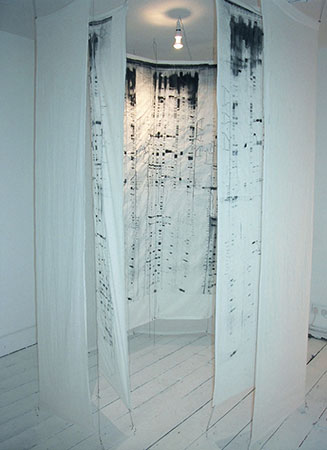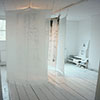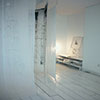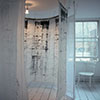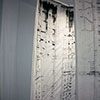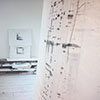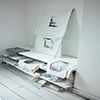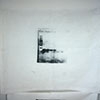RNA, DNA
Works in the Exhibition
RNA Installation
Silk screen of human RNA on linen, thread, steel cables.
Room, 15’ x 20’, Piece, 6’ x 6’ x 10’.
DNA Napkins and Printed Linens
Silkscreen photo on linen,
10” x 12”
Artist Statement
To Touch On Our Identity
“Intact”-<us>, Latin : “untouched, uninjured, entire, whole, complete”; afficere, Latin: “to do something to, to touch, work upon, to cause change”.1
“For it is possible to see without being seen, but to touch is always to be touched” 2
Patterns of identity, traditionally sewn on cloth or made through medical tests, represent a lexicon of signs and symbols. My work is an attempt to access and process the traditional and contemporary use, and misuse of these patterns. I have studied both traditional embroidery patterns used by the Palestinian culture, and ritual cloths used in Jewish culture. Key to my investigation of these contemporary identity patterns is the realization that Semites, Jews, and Palestinians, share a nearly identical DNA pattern. As a physical form these works are a synthesis of contemporary identify markers, such as chromosome tests, RNA gels, DNA gels, and the tradition of hand sewn and marked linens.
The cloth forms range from dress panels, veil, binders, curtains, and table linens. I am consciously utilizing these forms because they have traditionally been designed and worn by women. They cover the body or clean the body. They are skin-like and stain from any fluid mark.
Currently both RNA and DNA testing is the most direct way to determine genetic lineage. Most recently it has become a political tool for racial discrimination. The use of DNA and RNA will vastly change our lives. How this information is used and misused will define people according to medical, ethnic, and racial lines.
- Pennina Barnett, “Letters from the Editors”, Textile, 2003
- Denis Holier, "The Politics of Prose: Essay on Sartre”, 1986
RNA
This cylindrical cloth space made of stretched layers of sheer cloth mimics a hospital-curtained space. A human RNA Gel is silk-screened and sewn onto the inside of the cloths. RNA, representing our individual set of proteins, maps our chemical make-up. All human and animal RNA and DNA look almost the same. Only subtle alterations make us different. Recently RNA has been important in researching hereditary diseases. Essentially the stains or marks on the cloth indicate one’s level of various proteins. Light stains on the gel indicate lower levels. Higher levels create darker marks.
Low levels of proteins, which are passed on genetically, determine physical qualities, conditions, and diseases such as cancers, epilepsy, and depression. Through stitching, painting, and drawing onto an accurate RNA gel, I have altered, symbolically, the potential for a person to have a very different future and possibility to defy biological determinism. This type of literal alterations is the focus of current medical research to cure disease or create “superior” humans.
DNA Napkins
The DNA gels of my husband and son were silk-screened onto the sets of napkins and placed on the shelves in the left corner of the studio. This DNA test determines the sex and ethnic identity of the gene [I think the absoluteness here is debatable]. In this case, the DNA test shows that they are both males of Arab origin, perhaps the most scrutinized category of humans in Western society today.
DNA evidence has reached a new level of significance in the US with the proposal of Patriot Act II. This would allow the government to take DNA samples from all questioned and suspect persons, who may, according to law enforcement, have some connections to terrorist organizations. The DNA samples will be kept on file to track the suspect. DNA evidence is currently being used in most criminal cases in the US today.
Materials, Installation and Interaction
The traditional materials and processes of linen and embroidery carry a specific material semiotic and kinesthetic language. Experiences of touch, bodily comfort, and wrapping are central to my work. The phenomenological experience of walking into and around the work is essential. The viewer’s body can enter into this “skin,” walk around and look through this “body” represented by the cylindrical space. The shape and form of the work mimics a hospital curtain, or a lantern. The RNA is printed at the scale of the body; the DNA napkins are at the scale of the hand and face for wiping. This work was fabricated at Gasworks from January to March, 2003. The silkscreens were printed at London Print Works Trust.
I am particularly grateful to the following:
Gasworks, London, England.
Triangle Trust, London, England.
The Levine Fund, Reed College, Portland, Oregon.
London Print Works Trust, London, England.
Megan Murphy, a senior Human Biology/ Premedical student at Reed, for processing the DNA samples of Aden and Laurence Qamar.
Muña Qamar, for her assistance in printing the gels.
